Meital Katz-Minerbo
19.06.2018 – 07.09.2018
Exhibition Views
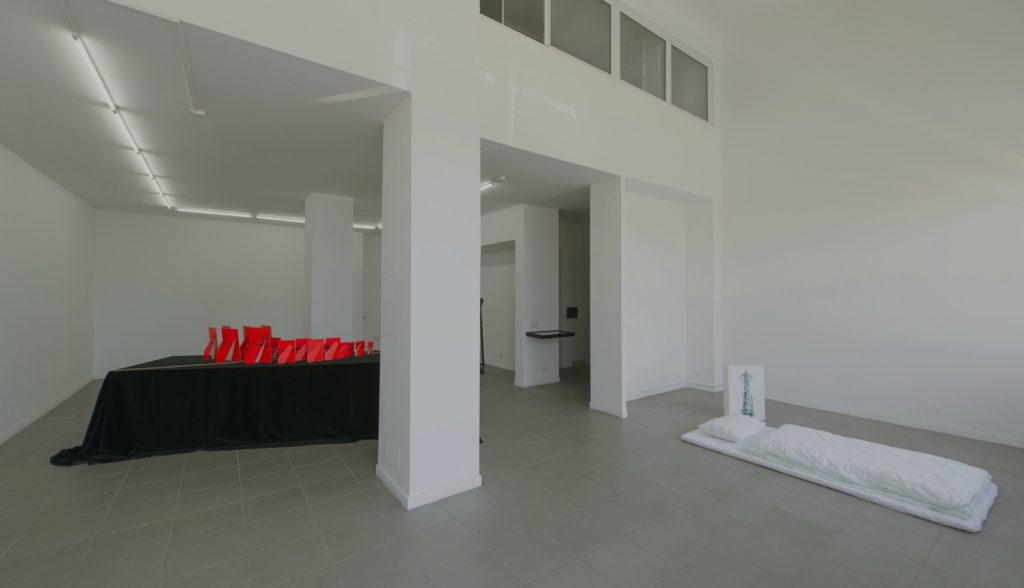
The Invisibility of Plants, installation view at The Gallery Apart (ground floor), photo by Giorgio Benni 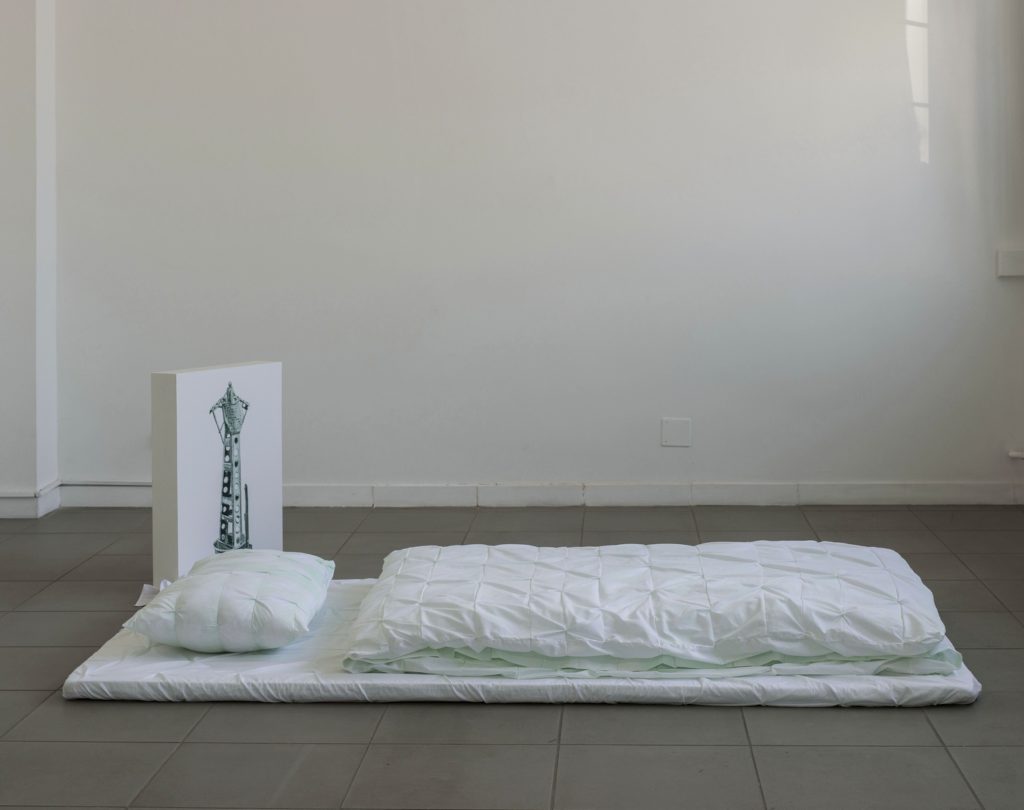
Portable bed installation, 2018, variable size, industrial lacquer, PVC and wood, fabric, foam and acrylic painting, ed. 1+1AP, photo by Giorgio Benni 
Portable bed installation, 2018, detail, photo by Giorgio Benni 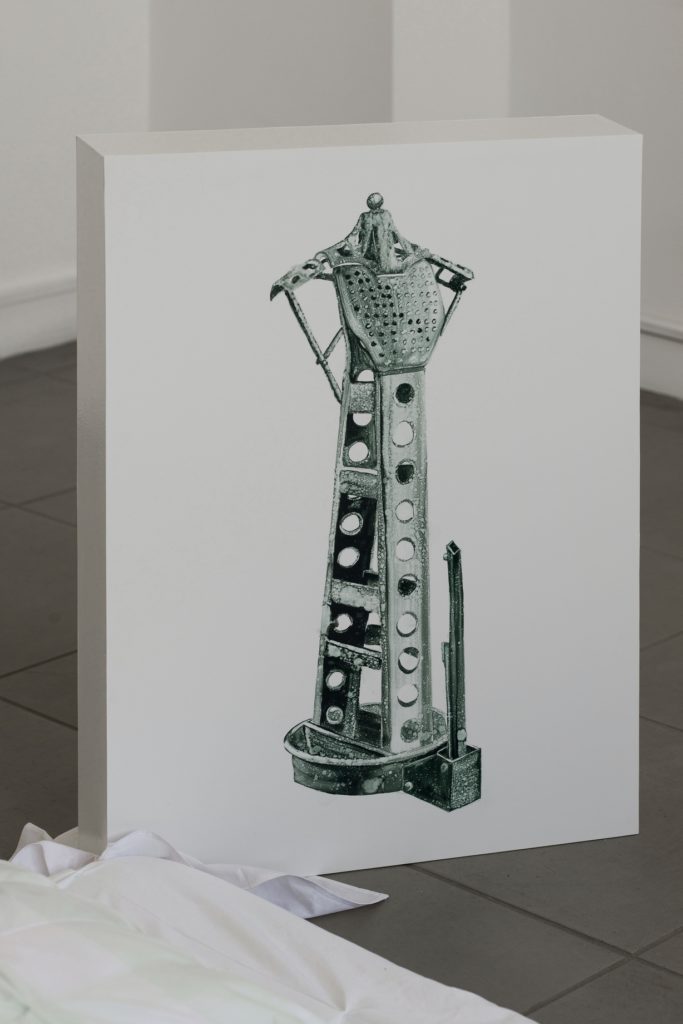
Bed side object, 2018, industrial lacquer, PVC and wood, 68x48x10, (front side), photo by Giorgio Benni 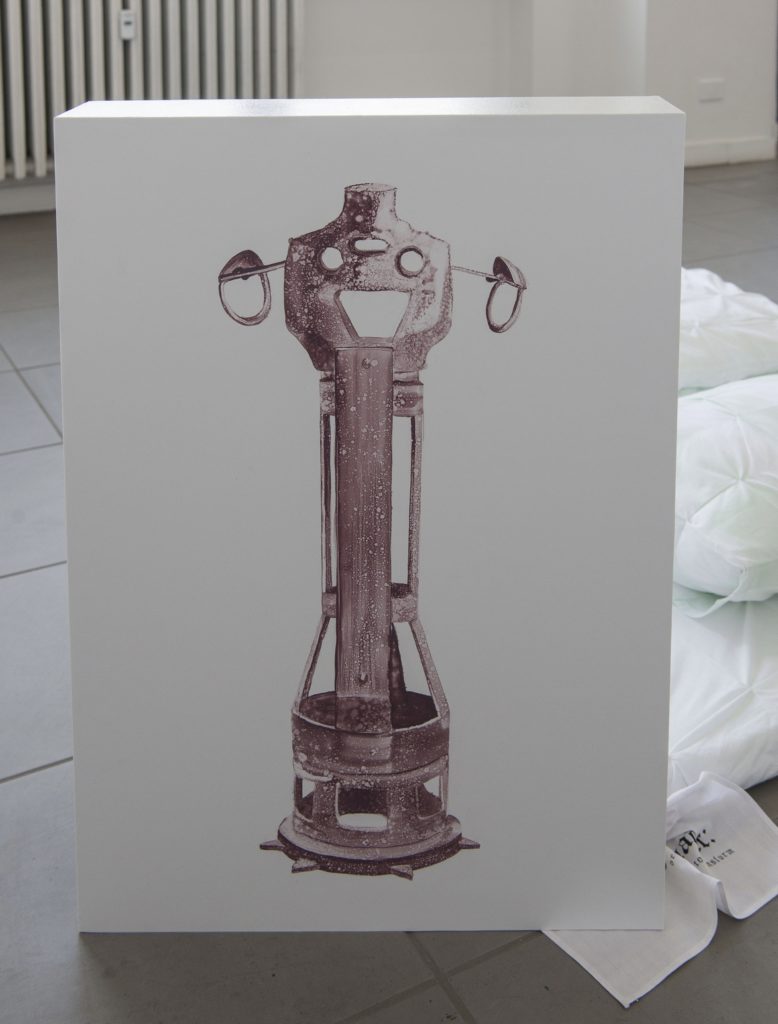
Bed side object, 2018, industrial lacquer, PVC and wood, 68x48x10, (rear side), photo by Giorgio Benni 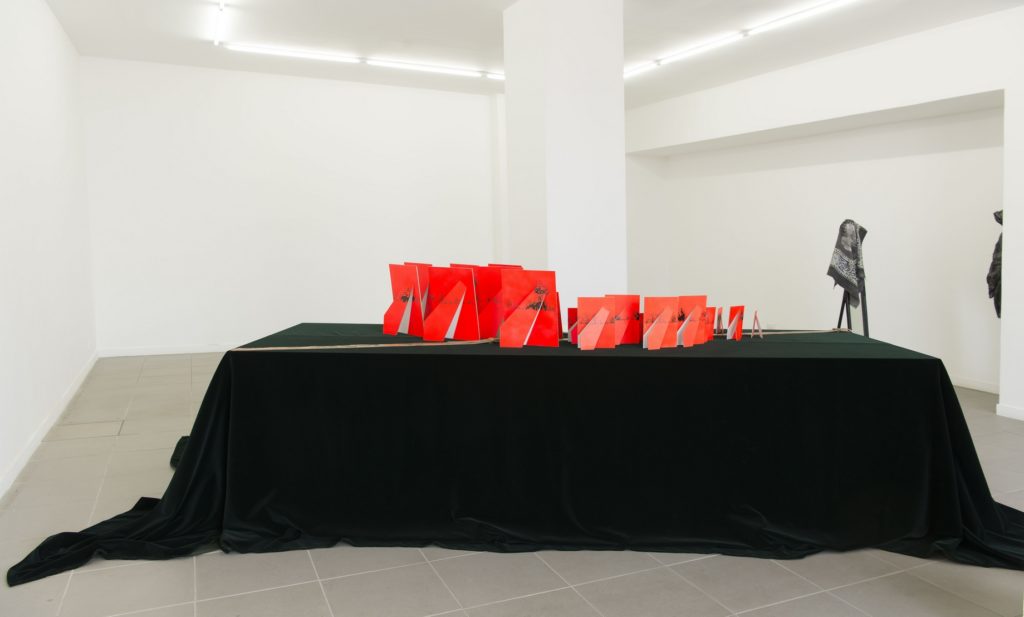
Vivi’s garden, 2018, variable size, mixed media, ed. 1+1AP, photo by Giorgio Benni 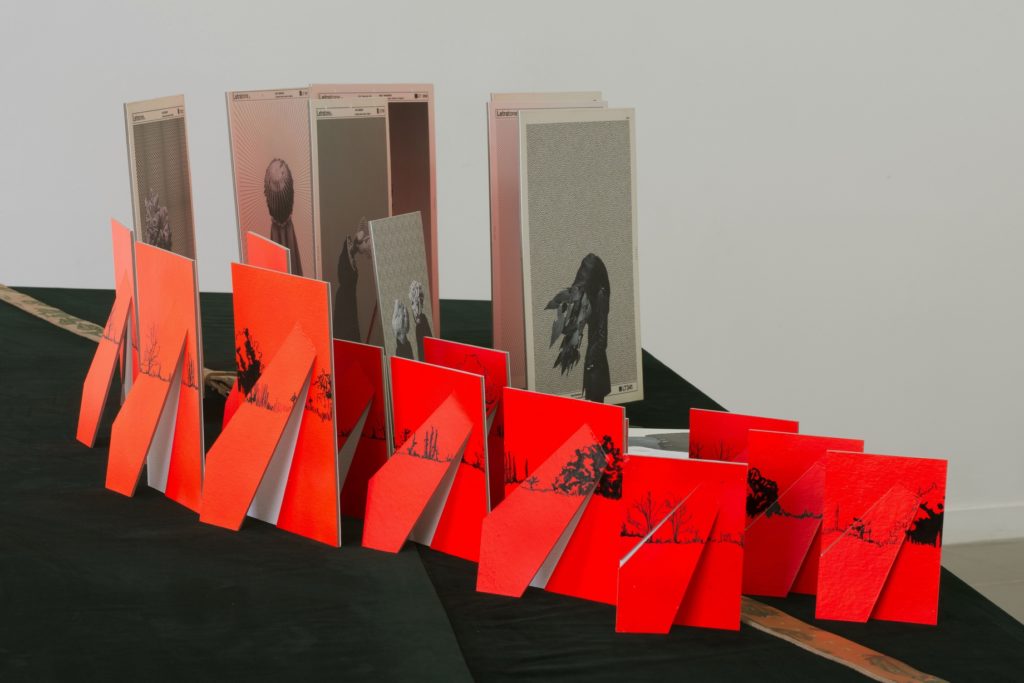
Vivi’s garden, 2018, variable size, mixed media, ed. 1+1AP (detail), photo by Giorgio Benni 
Vivi’s garden, 2018, variable size, mixed media, ed. 1+1AP (detail), photo by Giorgio Benni 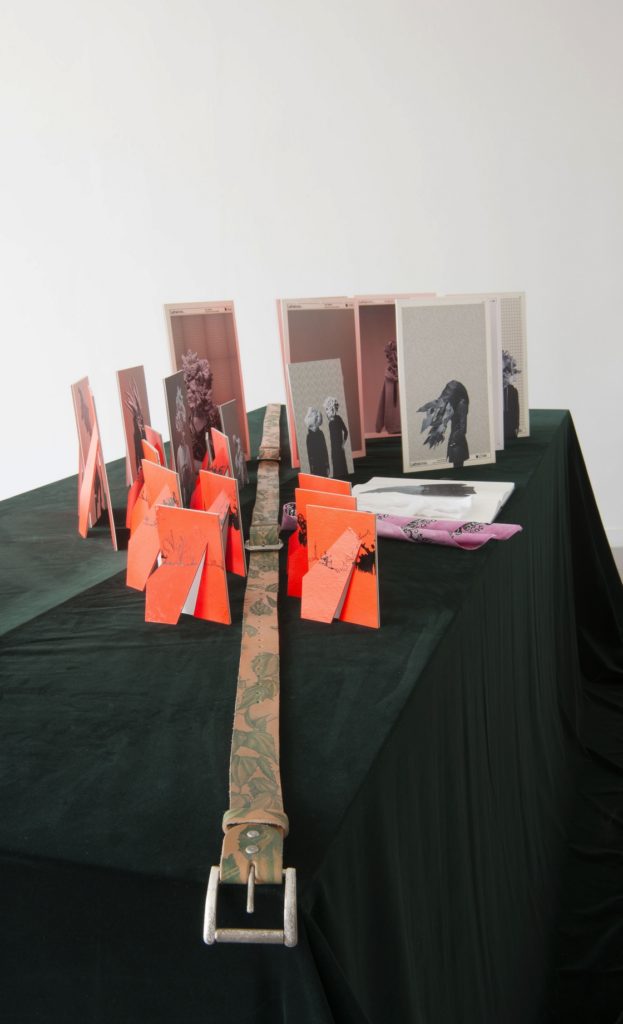
Vivi’s garden, 2018, variable size, mixed media, ed. 1+1AP (detail), photo by Giorgio Benni 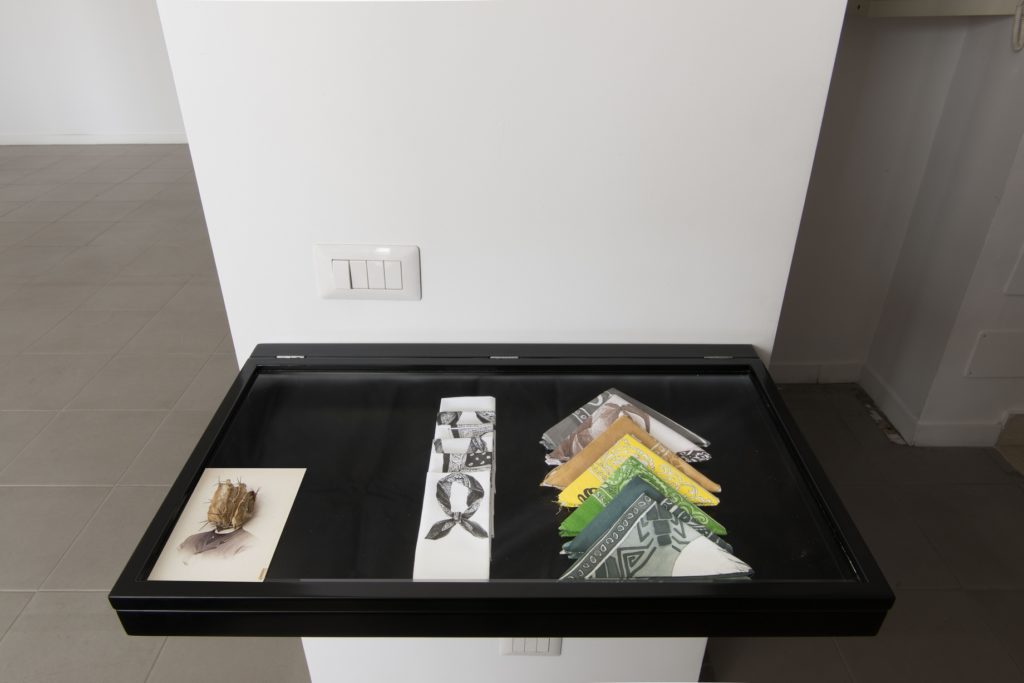
Personal vitrine, 2018, variable sizes, mixed media, ed 1+1AP, photo by Giorgio Benni 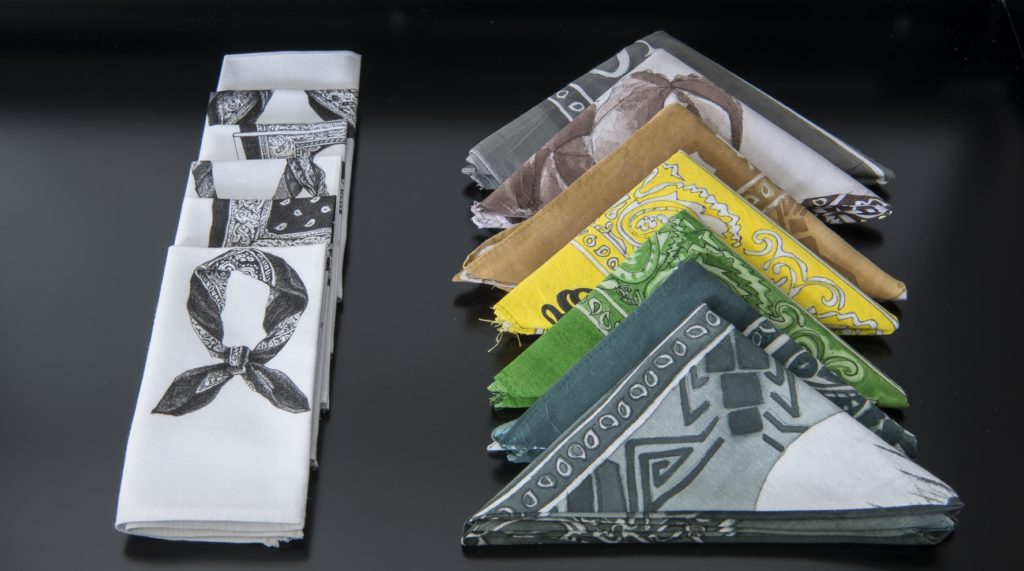
Personal vitrine, 2018, variable sizes, mixed media, ed 1+1AP, photo by Giorgio Benni 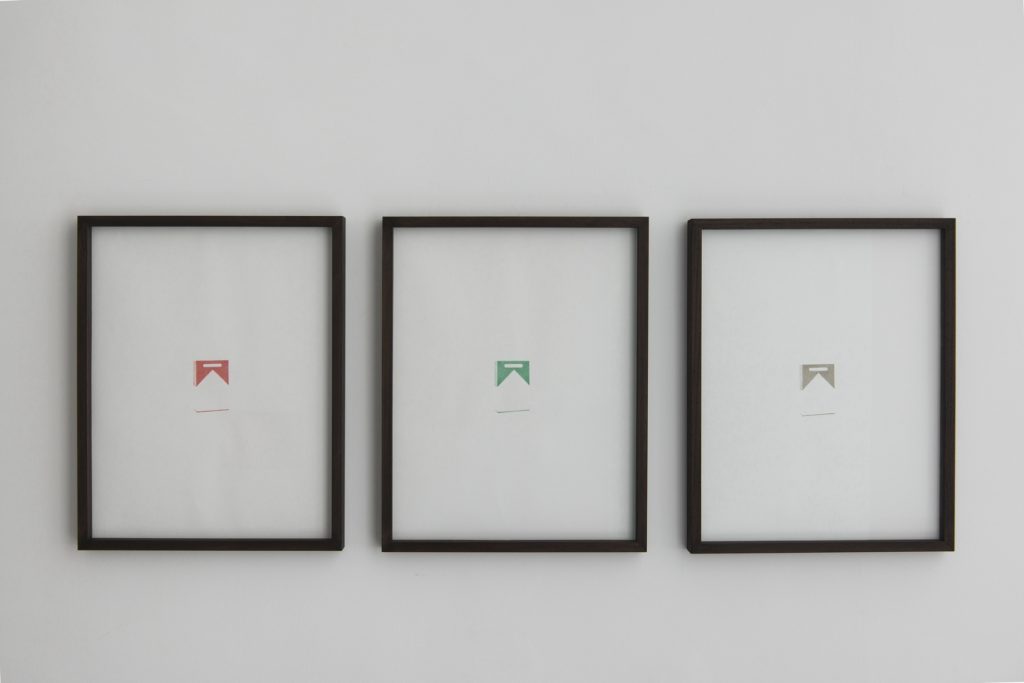
Red House; Green House; Golden House, 2018, pencil on paper, 52×41 cm each, photo by Giorgio Benni 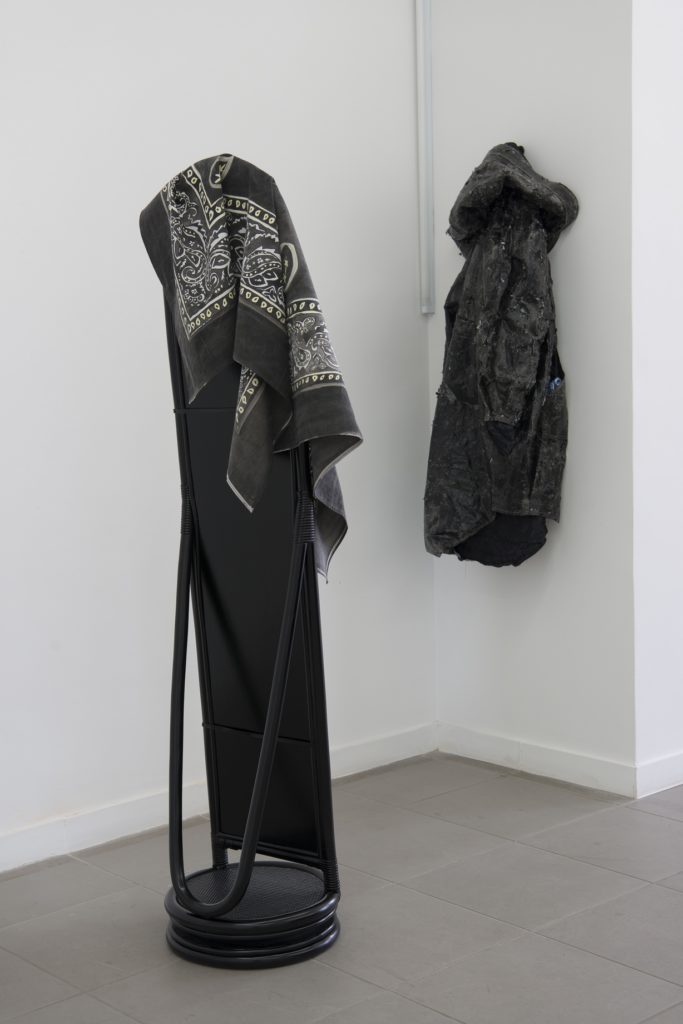
Lobby, 2018, variable size, jacket painted with industrial laquer, paper, bandana painting and rattan mirror, ed. 1+1AP, photo by Giorgio Benni 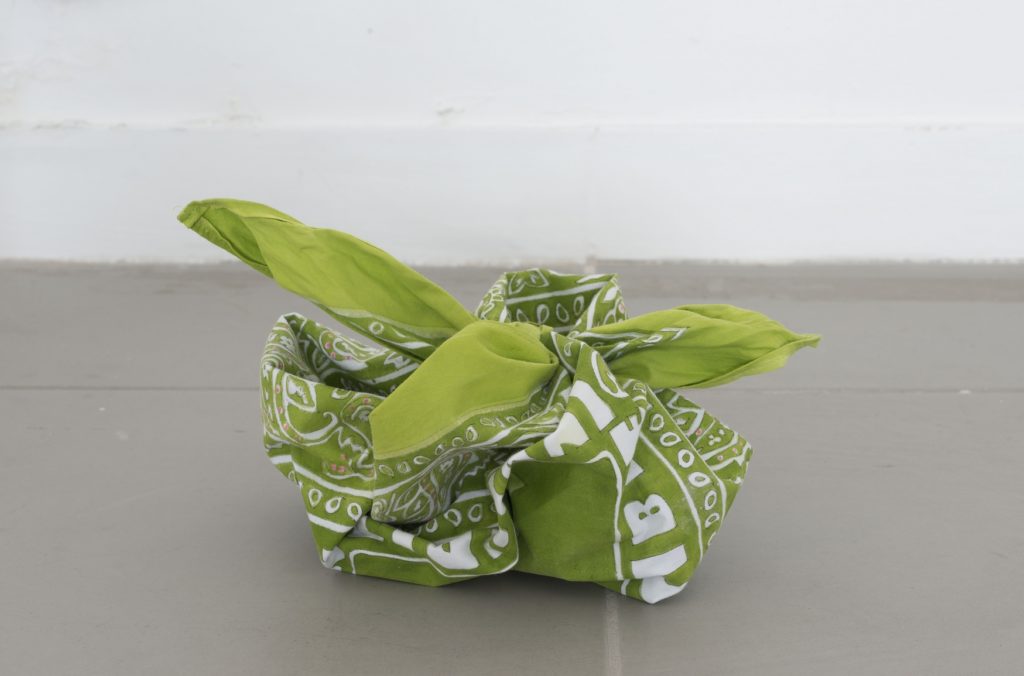
Invisible, 2018, variable sizes, painted bandana, loudspeaker, sound, photo by Giorgio Benni 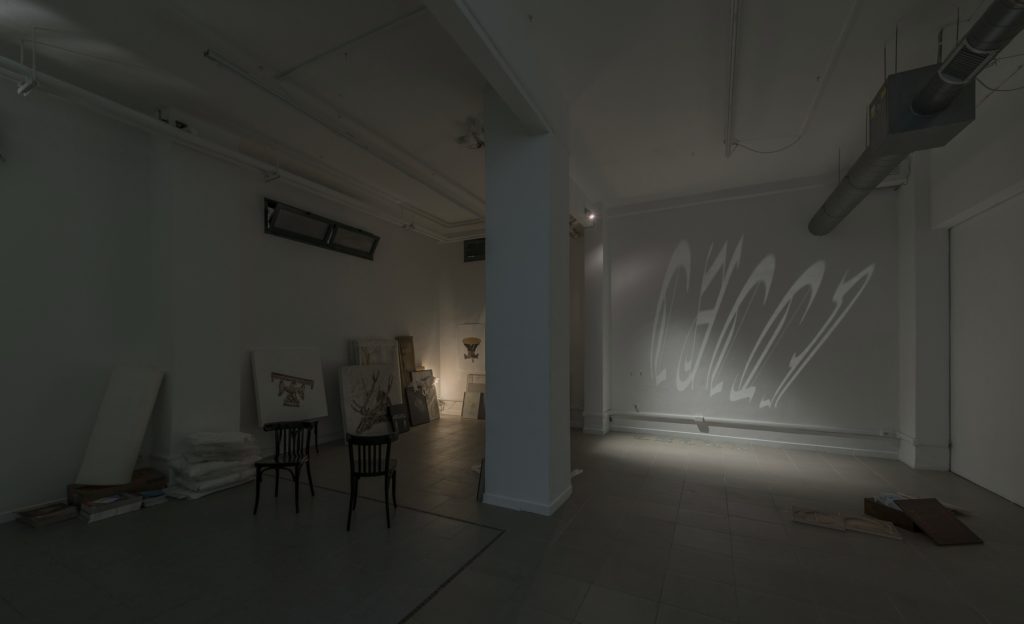
The Invisibility of Plants, installation view at The Gallery Apart (basement), photo by Giorgio Benni 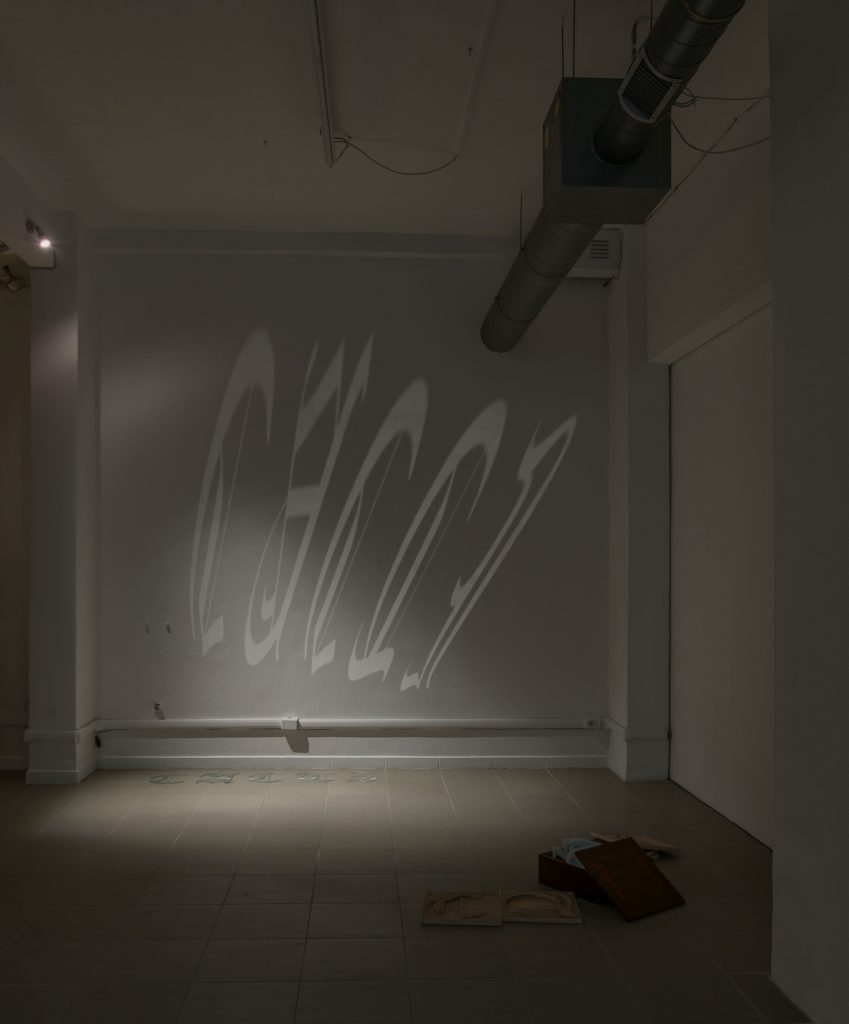
CACTI, 2018, mirror letters, light, ed. 1/6, photo by Giorgio Benni 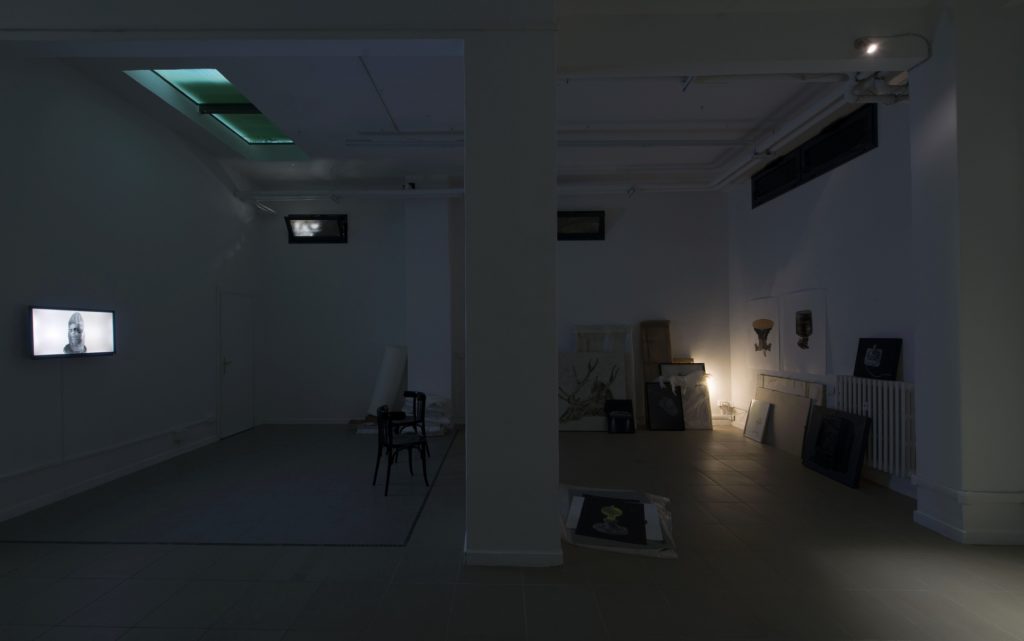
The Invisibility of Plants, installation view at The Gallery Apart (basement), photo by Giorgio Benni 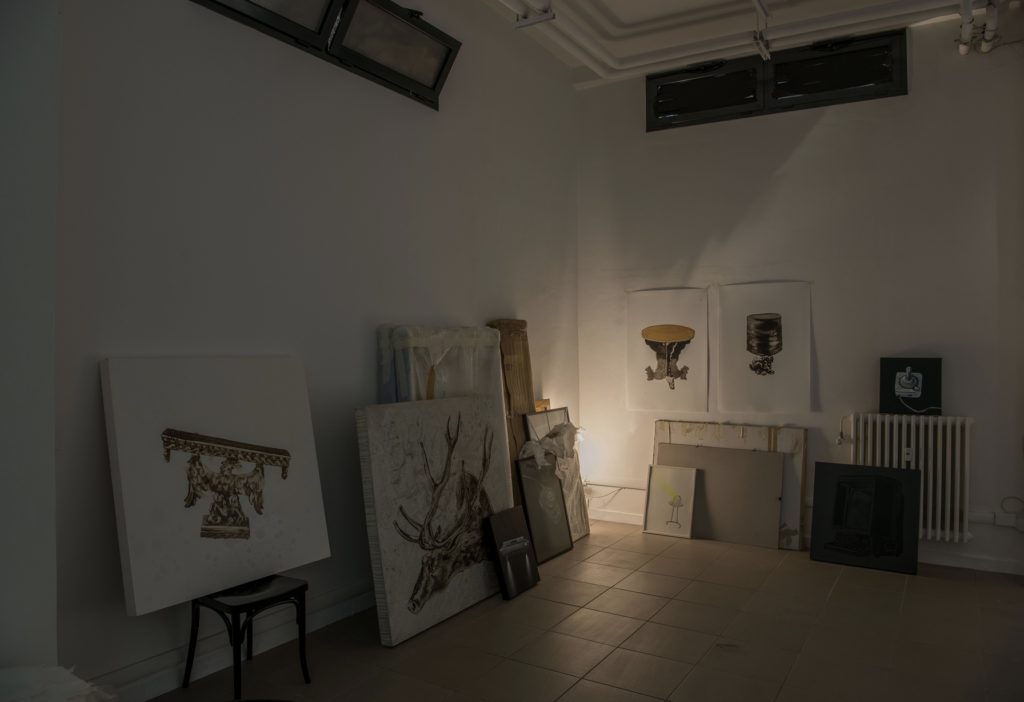
The Invisibility of Plants, installation view at The Gallery Apart (basement), industrial laquer on canvas, PVC and paper, photo by Giorgio Benni
Works
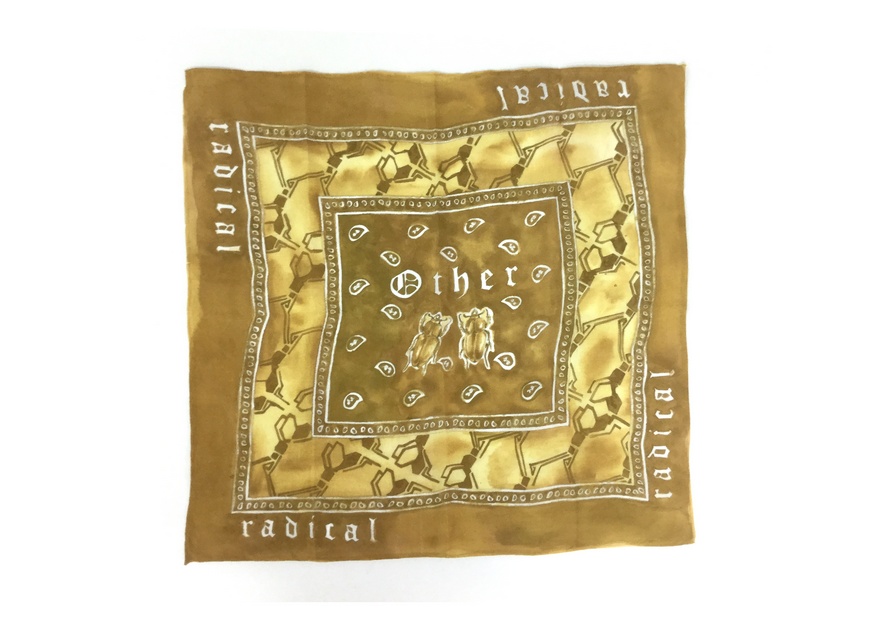
Bandana painting (Ocre), 2018, acrylic on cotton, 62 X 62 cm 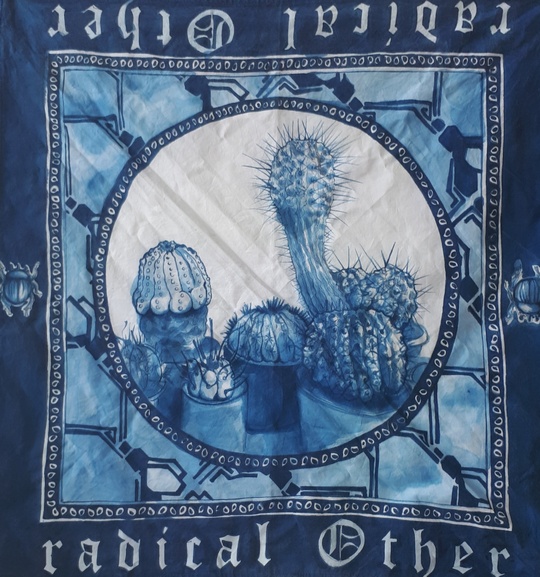
Bandana painting (Blue), 2018, acrylic on cotton, 54 X 54 cm 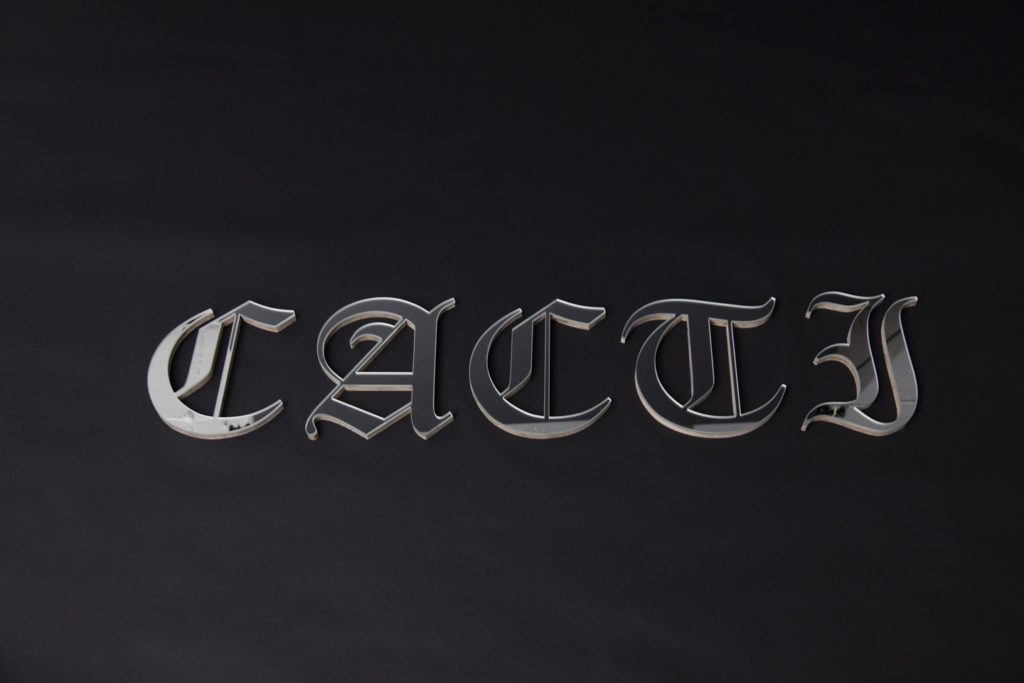
CACTI, 2018, mirror letters, light, ed. 1/6 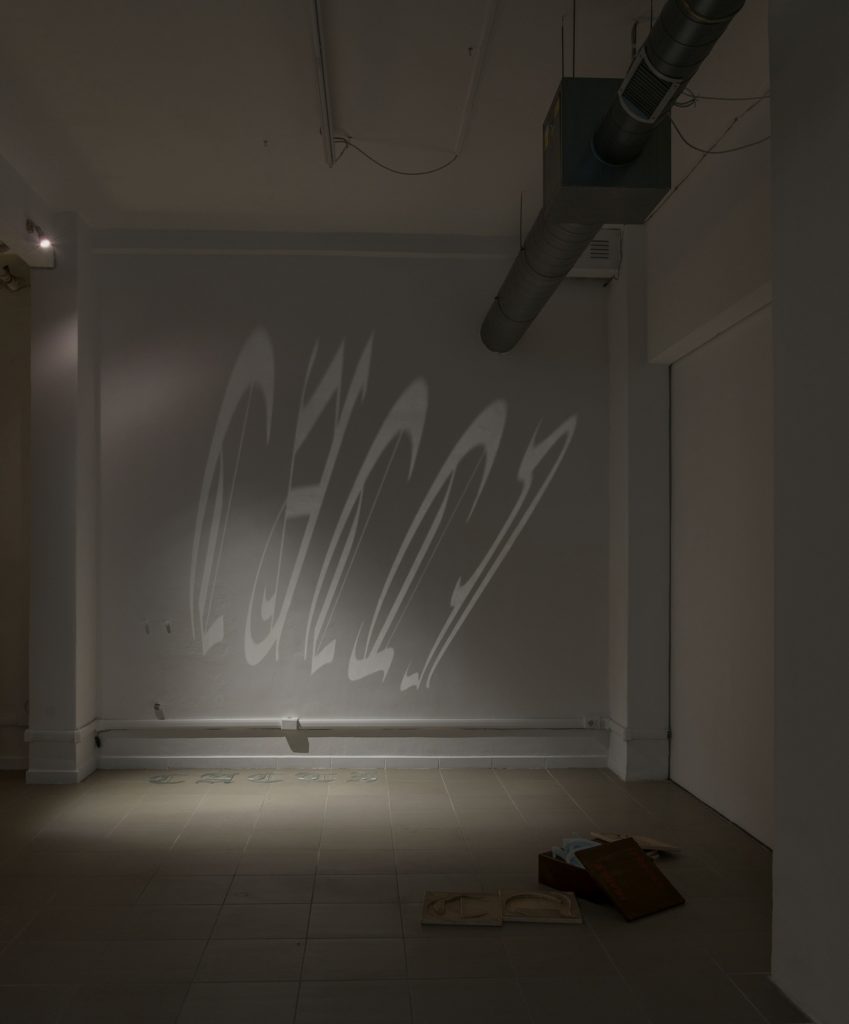
CACTI, 2018, mirror letters, light, ed. 1/6, photo by Giorgio Benni 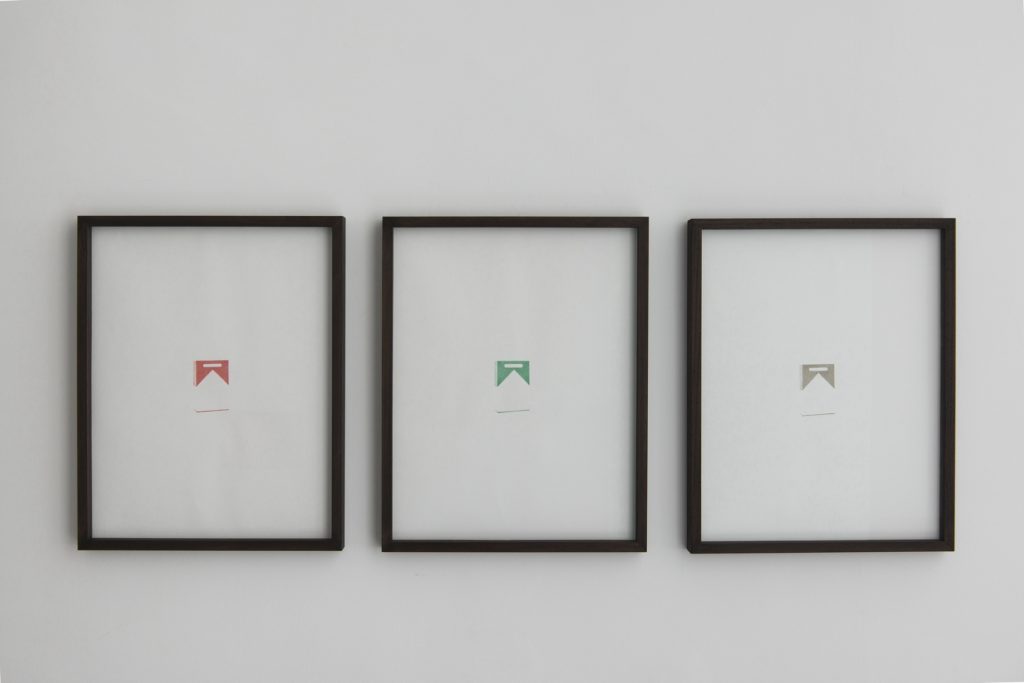
Red House; Green House; Golden House, 2018, pencil on paper, 52×41 cm each, photo by Giorgio Benni 

Portable bed installation, 2018, industrial lacquer, PVC and wood, fabric, foam and acrylic painting, variable size, ed. 1+1AP, photo by Giorgio Benni 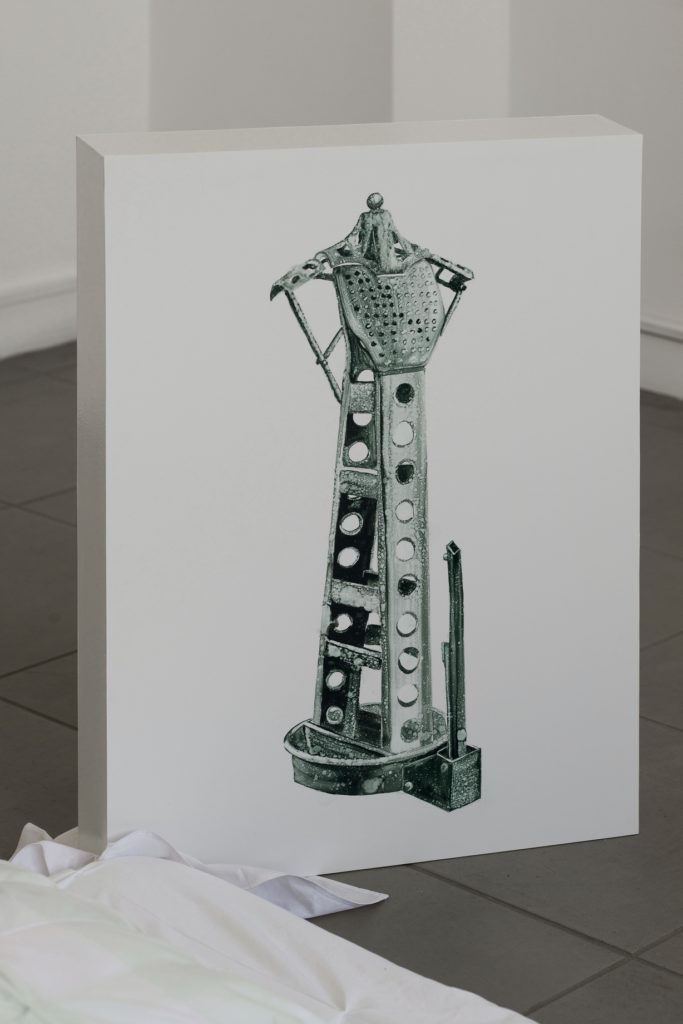
Bed side object, 2018, industrial lacquer, PVC and wood, 68x48x10, (front side), photo by Giorgio Benni 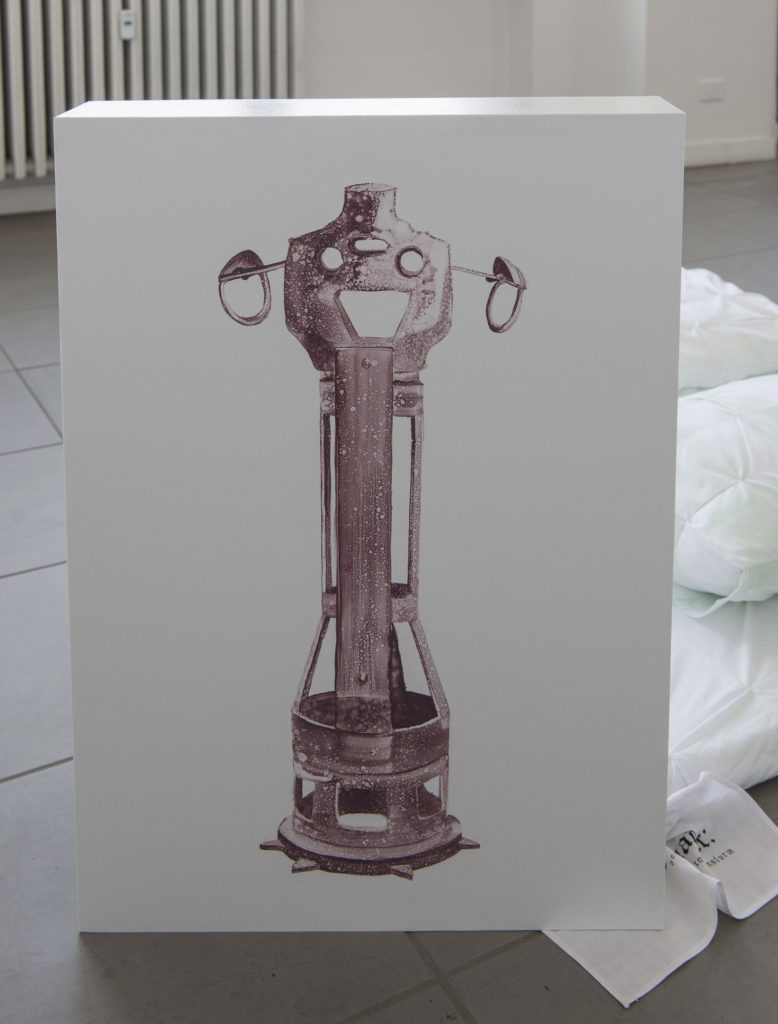
Bed side object, 2018, industrial lacquer, PVC and wood, 68x48x10, (rear side), photo by Giorgio Benni 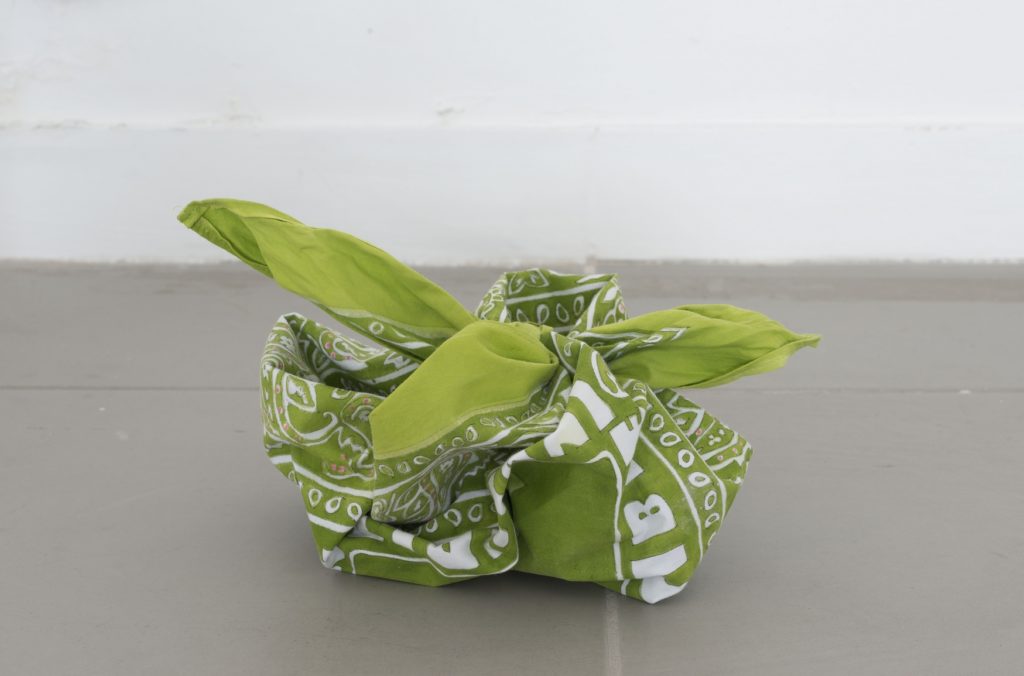
Invisible, 2018, painted bandana, loudspeaker, sound, variable sizes, photo by Giorgio Benni 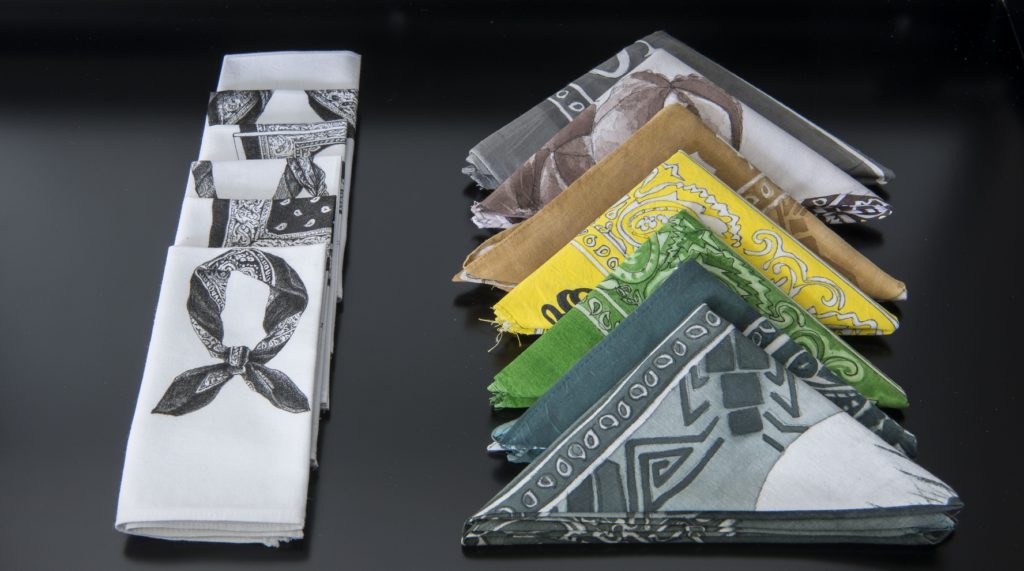
Personal vitrine, 2018, mixed media, ed 1+1AP, variable sizes, photo by Giorgio Benni 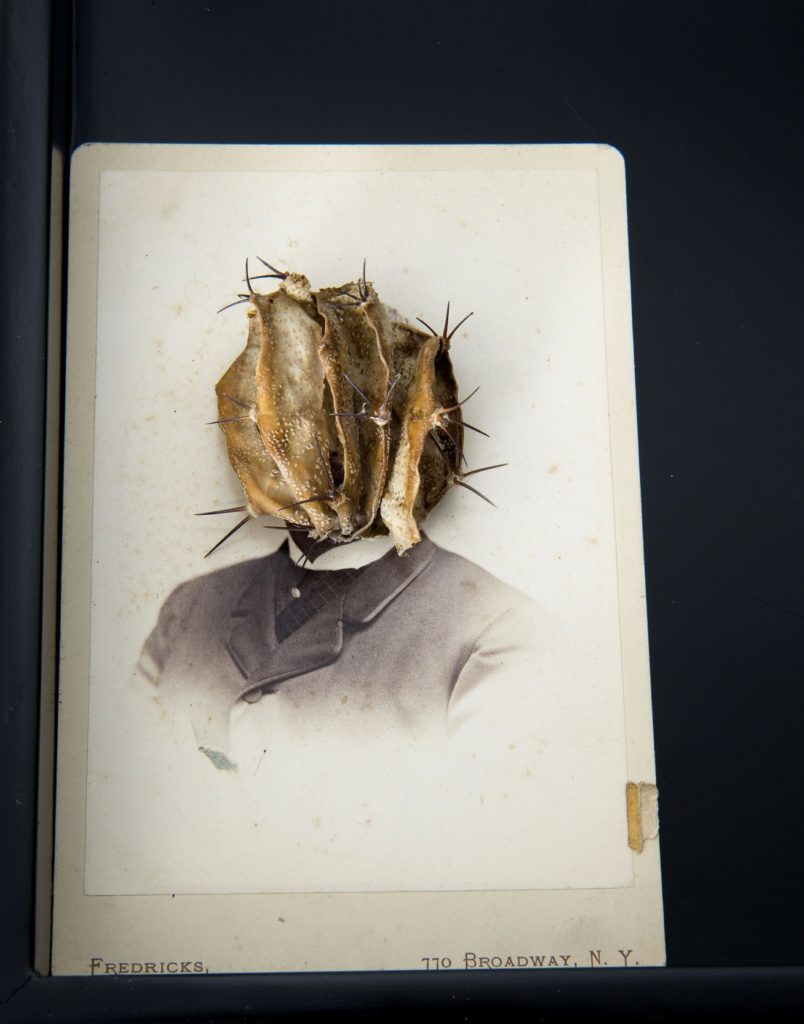
Personal vitrine, 2018, mixed media, detail of the contribution by Zaelia Bishop, photo by Giorgio Benni 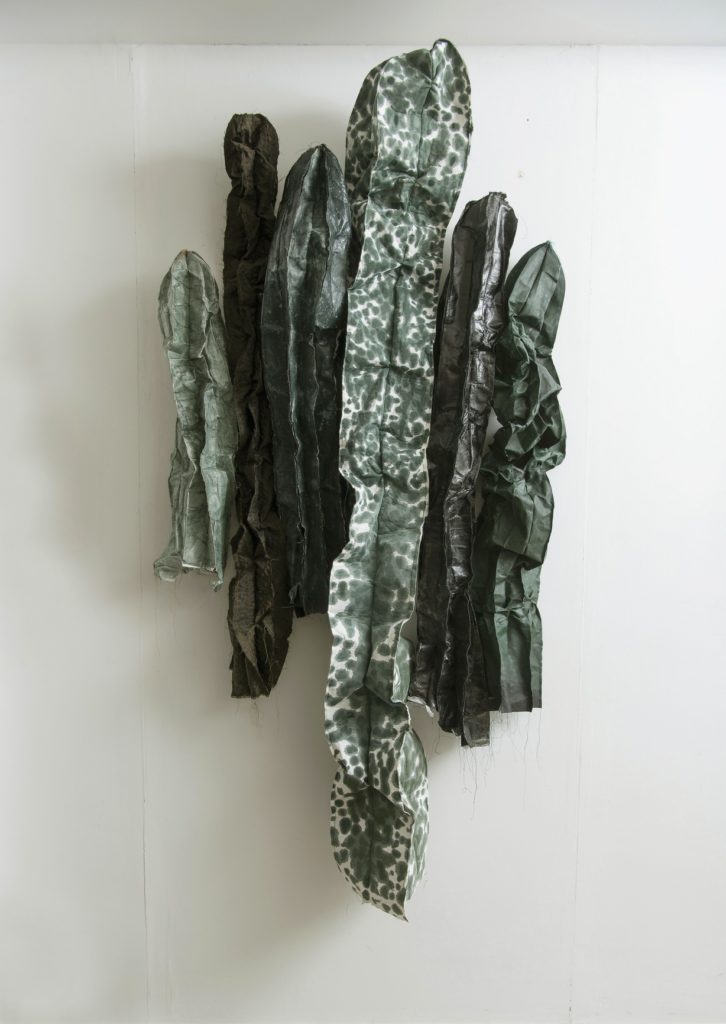
Vegetation confection, 2018, painted fabric, variable sizes, photo by Giorgio Benni 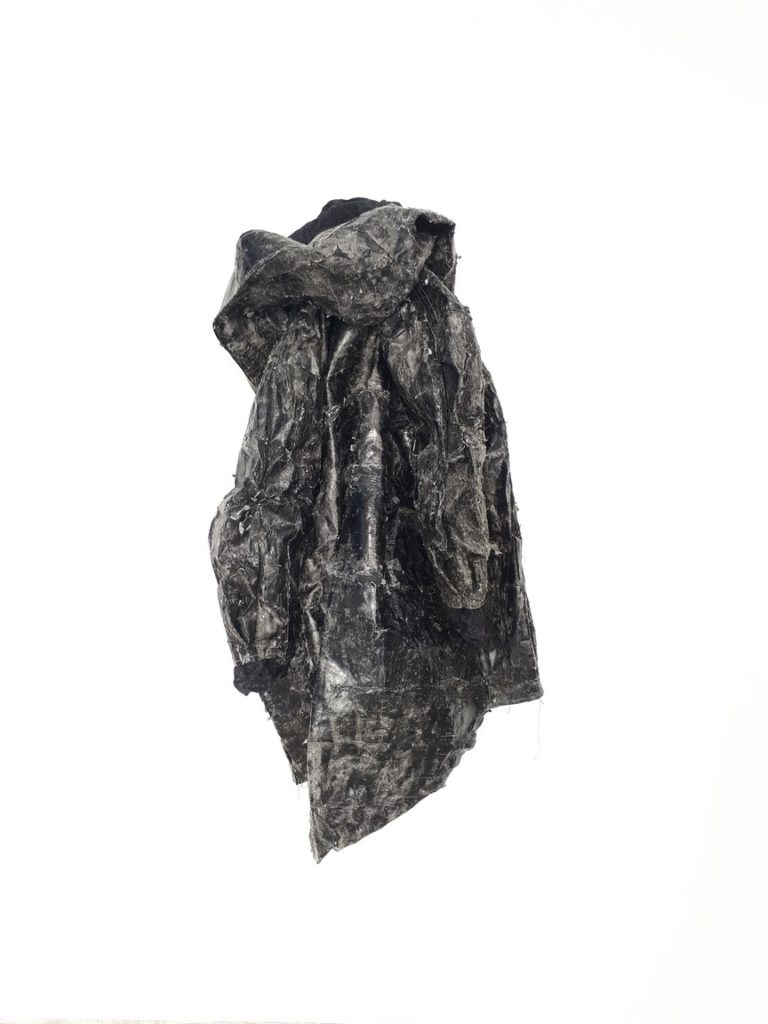
Black hoodie Jacket (by Cactus Man Brand), 2018, fabric, industrial laquer and paper, variable size 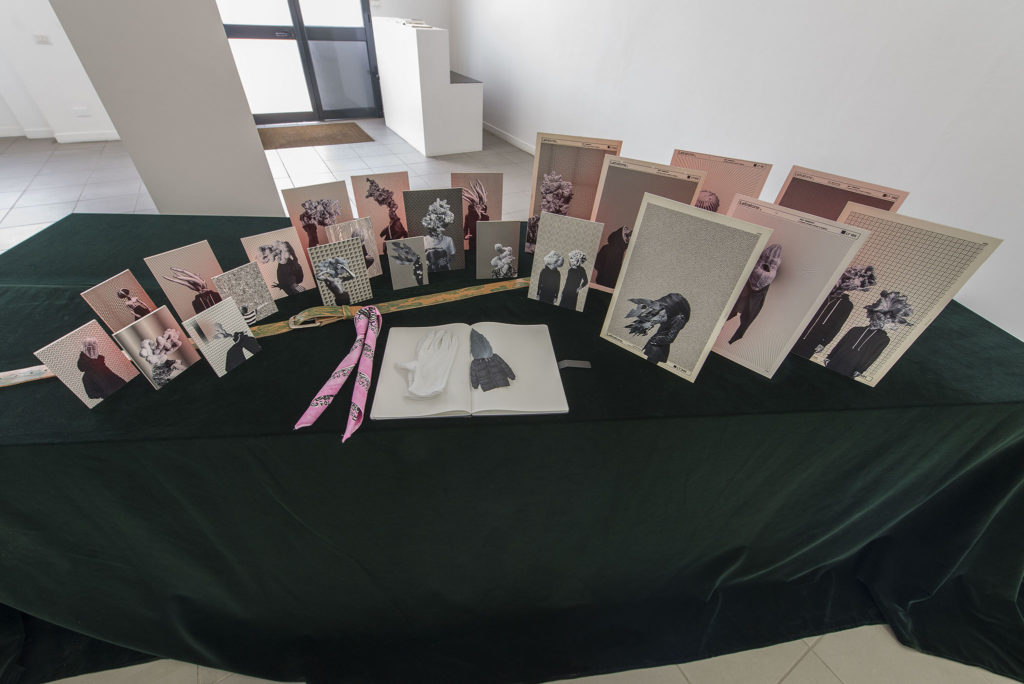
Vivi’s garden, 2018, mixed media, ed. 1+1AP, variable size, photo by Giorgio Benni 
Belt, 2018, leather, tatoo ink, metal, variable sizes 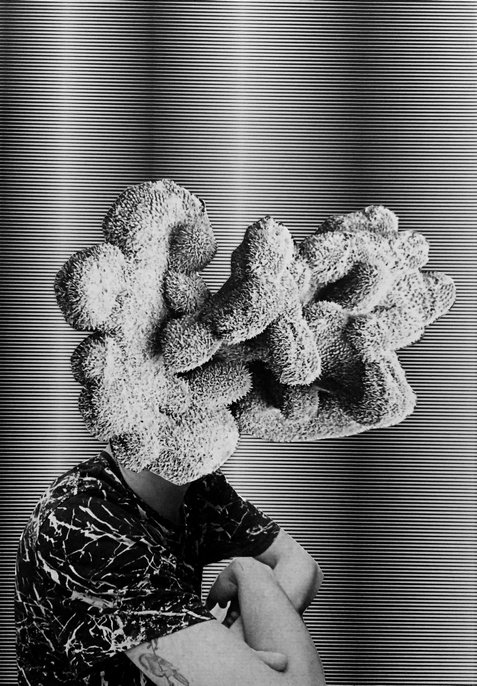
S1, 2018, collage, spray and ink on cardboard, 15 x 10.6 cm 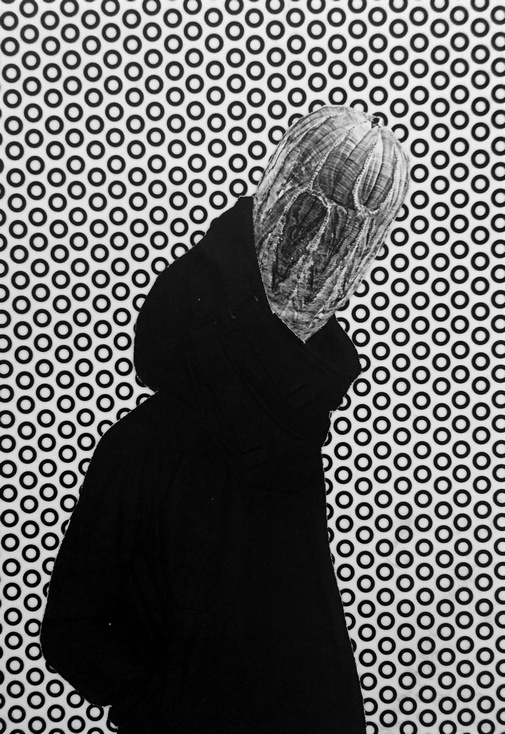
S3, 2018, collage, spray and ink on cardboard, 15 x 10.6 cm 
M1, 2018, collage, spray and ink on cardboard, 18 x 13 cm 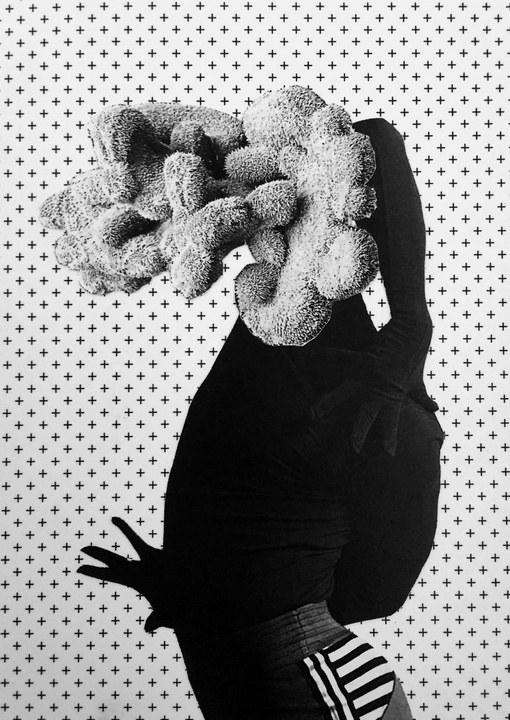
M2, 2018, collage, spray and ink on cardboard, 18 x 13 cm 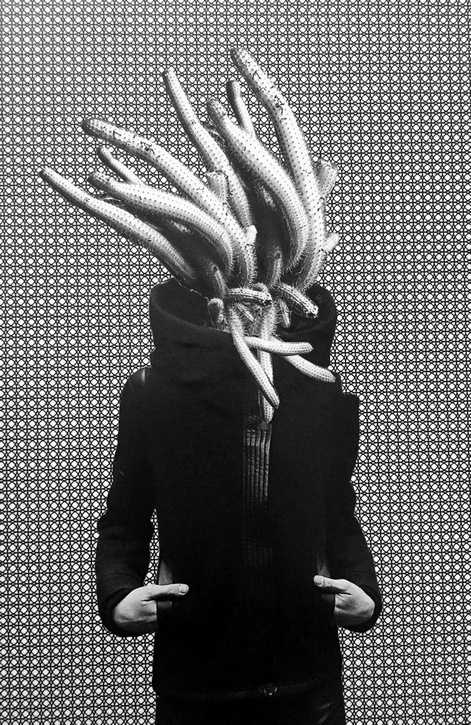
M1, 2018, collage, spray and ink on cardboard, 18 x 13 cm 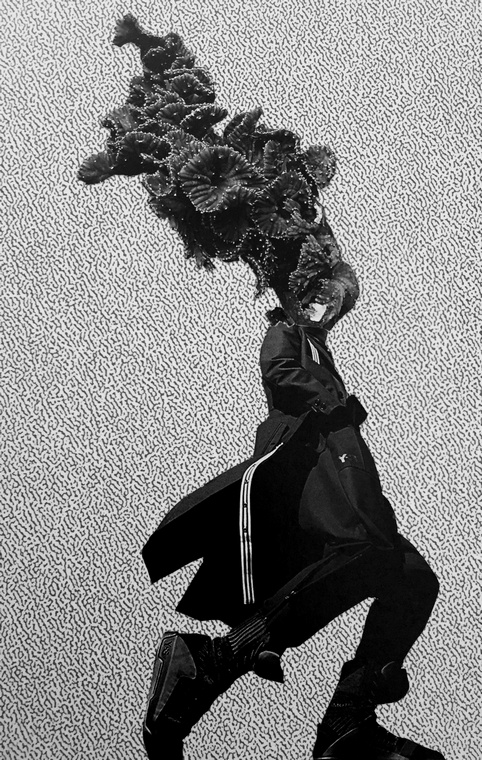
L1, 2018, collage, spray and ink on cardboard, 25,5×16,9cm 
XL8, 2018, collage, spray and ink on cardboard, 38,3 x 26,5 cm 
XL1, 2018, collage, spray and ink on cardboard, 38,3 x 26,5 cm 
XL7, 2018, collage, spray and ink on cardboard, 38,3 x 26,5 cm 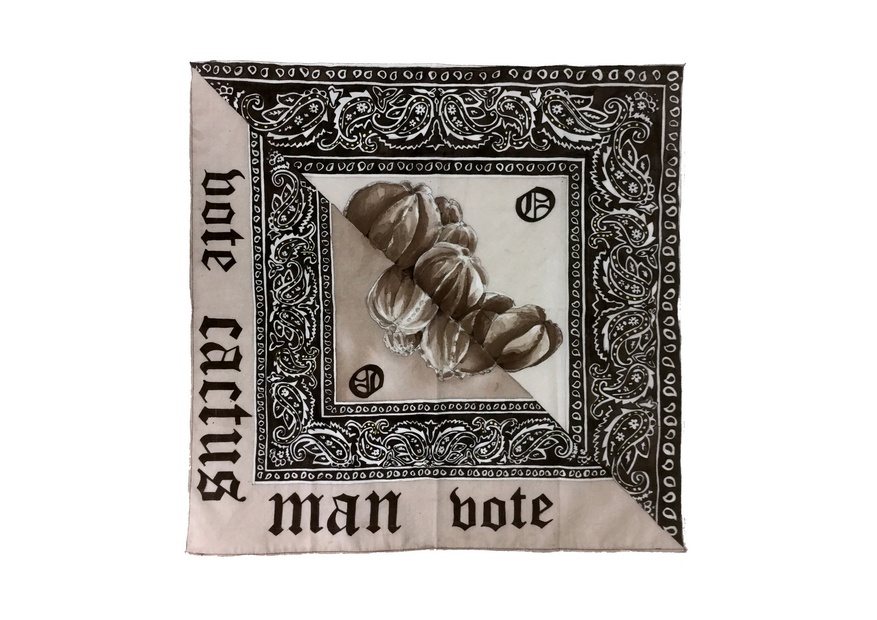
Bandana painting (Brown), 2018, acrylic on cotton, 62 X 62 cm
The Gallery Apart is proud to present The Invisibility of Plants, the second solo show hosted in the gallery spaces of Meital Katz-Minerbo, an Israeli artist based in Tel Aviv.
The artist continues to investigate key concepts in the history and chronicles of her country, while touching on sensitive matters that relate to the human condition. She stresses the definitions of gender through an ironic underlining of attitudes typical of male hegemony’s representation. She questions the meaning of housing and territory, in connection to concepts of mobility, permanence and nomadism, pointing out Ethics, especially in reference to their absence. Katz-Minerbo denotes the use of the body as an instrument of social status through garments and accessories used to cover and adorn it, as a platform for dialogue between humans, objects and the environment.
To lead us to question ourselves on these issues, Katz-Minerbo has given life in the last two years to the Cactus Man, a character that has become central in the practice of the artist focused on giving visual representations to definitions of otherness. The Cactus Man is a hybrid that combines a plant with a human being. Despite his monstrous appearance, he became well placed in the high ranks of society. His versatility and agile mobility inside capitalist structures allowed him to become wealthy. The Cactus Man is a thief. His skin is endless, for that his shape has no limits. Clothes are his skin; they cover his aberrant semblance in order to make him hard to recognize. He has two voices with two different accents, emitting sounds that contain the knowledge of two epochs. The Cactus Man is an empty shape ready to be filled.
The Cactus Man takes over the gallery spaces. He takes them up temporarily, as his style is based on mobility dictates and in line with the perennially changing conceptions of territory and body. A series of personal objects are disseminated in the gallery space alluding to a domestic place. They indicate the different areas of a specific and unknown home: a dining room, a bedroom and a basement. The group of objects can be easily put in a suitcase to be transported from the current residence to the next, where they will be displayed again, always maintaining the same sense of familiarity. It is not the traditional sedentary home. Katz-Minerbo presents an ever-moving house, a nomadic idea of a house belonging to a nomadic subject.
The ground floor of the house is structured as a normal private home; a bed that recalls the human nature of Cactus Man. The living area, with artworks on the walls, clothes on the hanger, a mirror, shelves to empty the pockets and a large table full of accessories, personal items and anything else Cactus Man uses to settle his relationship with the world. The basement is obscure and gloomy, as a less defined area of the house it represents the dark side of the Cactus Man. This is the room where the Capital takes part in commercial transactions. Two chairs placed inside a space that brings to mind a storage area, together with piles of paintings and a small amount of light that emanates from a monitor and a sculpture are the testimony of the act that took place there.
The Invisibility of Plants offers an original interpretation, reflected by the Cactus Man character, of an intellectual urgency that questions contemporaneity and highlights the end of anthropocentrism. Through the prism of the post-human criticism the superiority of the human over “other” living beings it’s questioned and reformulated into new structures of hierarchy and bodily forms. Meital Katz-Minerbo relates to the post-human discourse by exploiting the theme of the hybrid, so dear to the post-modern art of the last twenty years, with the intention to create a visual mediation between the variety of subjects that exists in this ever changing world.
The Gallery Apart è orgogliosa di presentare The Invisibility of Plants, la seconda personale in galleria di Meital Katz-Minerbo, artista israeliana di stanza a Tel Aviv.
L’artista prosegue la sua indagine intorno ad alcuni concetti chiave nella storia e nella cronaca del suo Paese ma che toccano temi sensibili per l’intera umanità: sottolinea il rapporto tra i generi attraverso una evidenziazione ironica di atteggiamenti propri della rappresentazione dell’egemonia maschile; interroga il significato di abitazione e di territorio, in relazione ai concetti di mobilità, stanzialità e nomadismo, mettendo in risalto l’etica, soprattutto con riferimento alla sua assenza; individua nell’uso del corpo uno strumento di posizionamento sociale mediante gli indumenti e gli accessori utilizzati per coprirlo ed adornarlo, come se il corpo fosse una piattaforma di dialogo fra uomini, oggetti e ambienti.
Per indurci ad interrogarci su queste tematiche, Katz-Minerbo ha dato vita negli ultimi due anni a Cactus Man, un personaggio divenuto centrale nella pratica dell’artista focalizzata sul dare rappresentazioni visive a definizioni di alterità. Cactus Man è una fusione tra una pianta e un essere umano. Malgrado l’aspetto mostruoso, si colloca ad un livello sociale alto. Cactus Man si muove agilmente e con grande versatilità all’interno delle strutture capitalistiche che gli garantiscono benessere. Cactus Man è un ladro. La sua pelle è infinita, per questo la sua forma non ha limiti. I vestiti sono la sua pelle; coprono la sua aberrante parvenza fino al punto da renderlo difficilmente riconoscibile. Ha due voci, con due accenti diversi, che emettono suoni che evocano due epoche distinte. Cactus Man è una forma vuota pronta per essere riempita.
Cactus Man si appropria degli spazi della galleria, li occupa temporaneamente come impone il suo stile improntato a mobilità e in linea con le sue concezioni perennemente mutevoli di territorio e corpo. Una serie di oggetti personali sono disseminati nello spazio della galleria, alludendo a uno luogo domestico e segnando le diverse aree di una casa specifica e sconosciuta: una sala da pranzo, una camera da letto e un seminterrato. Il gruppo di oggetti può essere facilmente messo in una valigia per essere trasportato dalla residenza attuale alla successiva dove verrà nuovamente visualizzato, mantenendo sempre lo stesso senso di familiarità. Non è la tradizionale casa sedentaria. Katz-Minerbo presenta una casa in perenne movimento, un’idea nomade di una casa che appartiene a un soggetto nomade.
Al pianterreno la casa è strutturata come una normale abitazione privata, con un letto a richiamare la natura umana di Cactus Man. E poi la zona giorno, con opere alle pareti, indumenti appesi all’appendiabiti, uno specchio, mensole dove svuotare le tasche e un grande tavolo stracolmo di accessori, oggetti personali e quant’altro Cactus Man utilizza per regolare la sua relazione col mondo. Il basement invece è buio e cupo, quale area meno definita della casa rappresenta il lato oscuro di Cactus Man. E’ la stanza dove il Capitale partecipa alle transazioni commerciali. Due sedie posizionate nello spazio a richiamarne il carattere di deposito insieme a pile di dipinti e una luce fioca che emana da uno specchio e da una scultura sono la testimonianza dell’attività che si svolge all’interno dello spazio stesso.
The Invisibility of Plants offre una interpretazione originale, ancorché traslata mediante il personaggio Cactus Man, di una urgenza intellettuale che interroga la contemporaneità sottolinenando la fine dell’antropocentrismo. Attraverso il prisma della critica sul post-umano, la superiorità dell’uomo rispetto alle altre forme di esseri viventi viene messa in discussione e riformulata entro nuove strutture gerarchiche e nuove forme corporee. Meital Katz-Minerbo si relazione al tema del post-umano sfruttando il tema dell’ibrido, così caro a tanta arte postmoderna dell’ultimo ventennio, con l’intenzione di creare una mediazione visuale tra la varietà di soggetti esistenti in questo mondo in continuo cambiamento.
share on